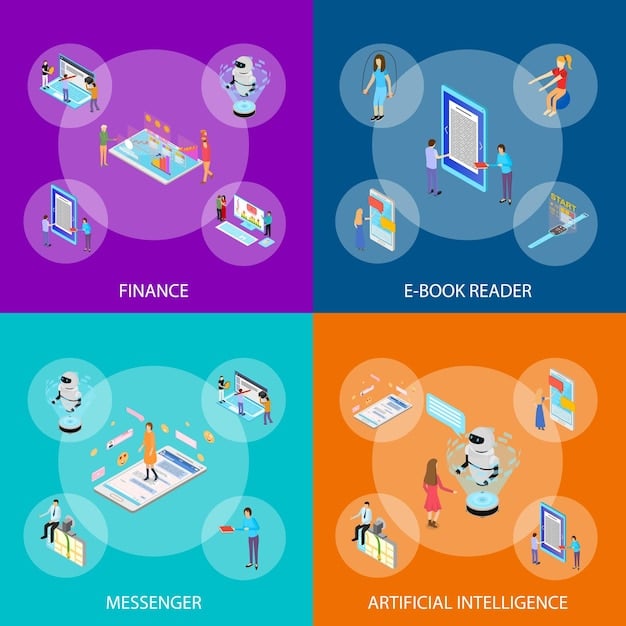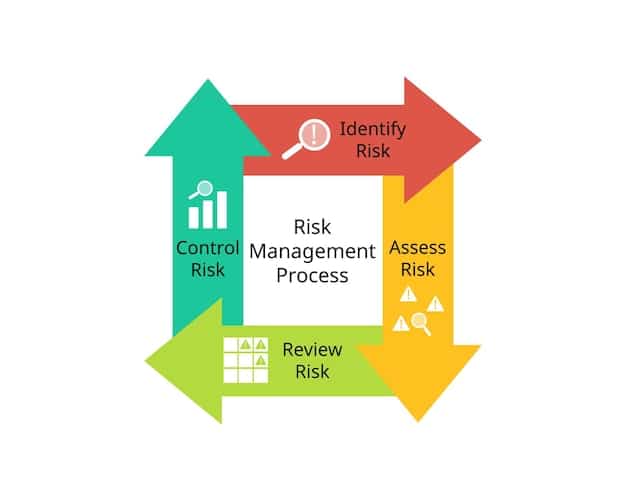AI Regulation in the US: Navigating Complexities & Ethical Concerns

The US faces the challenge of regulating artificial intelligence (AI) to foster innovation while addressing ethical concerns such as bias, privacy, and job displacement, requiring a balanced approach through legislation and industry collaboration.
The rapid advancement of artificial intelligence (AI) presents both tremendous opportunities and complex challenges for the United States. How the nation navigates the complexities of AI regulation, while carefully considering the potential ethical considerations, will significantly shape its future.
Understanding the AI Landscape in the US
Artificial intelligence is no longer a futuristic concept; it’s a present-day reality transforming industries and daily life in the US. From self-driving cars to medical diagnoses and personalized marketing, AI’s applications are vast and rapidly expanding. Understanding this landscape is the first step towards effective regulation.
Current State of AI Adoption
AI adoption varies across sectors, with technology, finance, and healthcare leading the way. Companies are leveraging AI to automate tasks, improve decision-making, and create new products and services. However, this widespread adoption also brings potential risks.
Key Players and Stakeholders
The AI ecosystem involves a diverse group of stakeholders, including tech companies, government agencies, research institutions, and civil society organizations. Each has a unique perspective on the development and deployment of AI, emphasizing the need for an inclusive approach to regulation.
- Tech Companies: Drive innovation and implementation.
- Government Agencies: Shape policy and ensure compliance.
- Research Institutions: Advance AI knowledge and ethical guidelines.
- Civil Society Organizations: Advocate for responsible AI practices.
In summary, the current AI landscape in the US is dynamic and multifaceted, requiring a comprehensive understanding of its various components to effectively regulate it. Recognizing the roles and responsibilities of each stakeholder is crucial for developing a balanced and ethical framework.

Current Regulatory Approaches to AI
As AI becomes more pervasive, the need for regulatory frameworks to ensure its responsible development and deployment has become increasingly apparent. Currently, the US lacks a comprehensive federal law specifically governing AI. Instead, a patchwork of existing laws and agency guidance is being applied.
Existing Laws and Regulations
Several existing laws can be applied to AI, including those related to data privacy, consumer protection, and discrimination. For example, the Federal Trade Commission (FTC) has used its authority to pursue cases against companies for deceptive or unfair practices involving AI.
Agency Guidance and Initiatives
Various federal agencies have issued guidance and launched initiatives to address AI-related concerns. The National Institute of Standards and Technology (NIST) has developed a voluntary AI Risk Management Framework (AI RMF) to help organizations manage AI risks and promote trustworthy AI systems.
- AI Risk Management Framework (AI RMF): Provides guidance on identifying and managing AI risks.
- Executive Orders: Direct agencies to promote AI innovation and address potential risks.
- Industry Standards: Develop voluntary standards for AI development and deployment.
In brief, the current regulatory approach to AI in the US is fragmented, utilizing existing laws and agency guidance to address specific concerns. While these efforts are a starting point, many experts believe a more comprehensive and coordinated approach is necessary to effectively regulate AI.
Potential Legislative Frameworks for AI
Given the limitations of the current regulatory landscape, there is growing discussion about the need for new legislation specifically tailored to AI. Several legislative frameworks have been proposed, each with its own approach to balancing innovation and risk mitigation.

Risk-Based Approach
This approach would classify AI applications based on their potential risks, with higher-risk applications subject to stricter regulations. For example, AI systems used in critical infrastructure or healthcare would face greater scrutiny than those used for less sensitive tasks.
Sector-Specific Regulations
Rather than a single, overarching law, sector-specific regulations could be developed to address the unique challenges and opportunities posed by AI in different industries. This approach would allow for more tailored and effective regulation.
Ethical Guidelines and Principles
Some frameworks focus on establishing ethical guidelines and principles for AI development and deployment. These guidelines would emphasize fairness, transparency, accountability, and human oversight.
- Fairness: Ensuring AI systems do not discriminate against individuals or groups.
- Transparency: Making AI systems understandable and explainable.
- Accountability: Establishing clear lines of responsibility for AI outcomes.
- Human Oversight: Maintaining human control over critical AI decisions.
In conclusion, the potential legislative frameworks for AI vary in their scope and approach but share the common goal of promoting responsible AI innovation while mitigating potential risks. The ultimate framework will likely incorporate elements of each approach, balancing flexibility with clear regulatory standards.
Ethical Considerations in AI Regulation
Ethical considerations are central to the discussion of AI regulation. As AI systems become more sophisticated and autonomous, it is crucial to address potential ethical concerns such as bias, privacy, and job displacement. Ignoring these issues could lead to unintended consequences and erode public trust in AI.
Bias and Discrimination
AI systems can perpetuate and amplify existing biases if trained on biased data. This can lead to discriminatory outcomes in areas such as hiring, lending, and criminal justice. Ensuring fairness and non-discrimination is a key ethical imperative.
Privacy and Data Security
AI systems often rely on vast amounts of data, raising concerns about privacy and data security. Regulations must address how data is collected, used, and protected to minimize the risk of privacy violations and data breaches.
Job Displacement and Economic Inequality
The automation potential of AI raises concerns about job displacement and increasing economic inequality. Policymakers must consider how to mitigate these effects through education, retraining, and social safety nets.
In summary, ethical considerations are paramount in AI regulation. Addressing issues such as bias, privacy, and job displacement is essential to ensure that AI benefits society as a whole and does not exacerbate existing inequalities. Prioritizing ethical principles will foster trust in AI systems.
Challenges and Opportunities in AI Regulation
Regulating AI presents both significant challenges and unique opportunities for the US. Balancing innovation with risk mitigation, addressing the rapidly evolving nature of AI, and coordinating across different levels of government are all key considerations.
Balancing Innovation and Regulation
One of the biggest challenges is finding the right balance between promoting AI innovation and implementing regulations to mitigate potential risks. Overly strict regulations could stifle innovation, while lax regulations could lead to harmful consequences. A flexible and adaptive approach is needed.
Adapting to Rapid Technological Change
AI technology is constantly evolving, making it difficult for regulations to keep pace. Regulations must be designed to be adaptable and forward-looking, allowing for adjustments as new technologies and applications emerge.
Coordination and Collaboration
Effective AI regulation requires coordination and collaboration across different levels of government, as well as between government, industry, and academia. A unified approach is essential to avoid duplication of efforts and conflicting regulations.
In conclusion, regulating AI presents complex challenges but also offers significant opportunities for the US to lead the way in responsible AI development and deployment. By carefully balancing innovation and risk mitigation, adapting to technological change, and fostering collaboration, the US can create a regulatory environment that promotes both economic growth and social well-being.
The Future of AI Regulation in US Politics
The future of AI regulation in US politics hinges on ongoing debates and policy decisions that will shape the legal and ethical landscape for years to come. As AI becomes increasingly intertwined with various aspects of society, the need for clear and comprehensive regulations will only intensify.
Anticipated Policy Changes
Several policy changes are anticipated in the coming years, including the potential passage of new AI-specific legislation, the issuance of updated agency guidance, and the development of new industry standards. These changes will likely reflect ongoing discussions about the best way to balance innovation and risk mitigation.
Impact on the US Economy and Society
The way AI is regulated will have a profound impact on the US economy and society. Effective regulation can unleash the full potential of AI to drive economic growth, improve healthcare, and enhance quality of life. However, poorly designed regulation could stifle innovation and lead to unintended consequences.
The Role of Public Discourse
Public discourse will play a critical role in shaping the future of AI regulation. Engaging the public in conversations about the ethical, social, and economic implications of AI is essential to ensure that regulations reflect societal values and priorities.
In essence, the future of AI regulation in US politics is uncertain, but it is clear that policymakers face significant challenges and opportunities. By engaging in thoughtful debate, considering diverse perspectives, and prioritizing ethical principles, the US can create a regulatory environment that fosters responsible AI innovation and benefits society as a whole.
| Key Point | Brief Description |
|---|---|
| 🤖 AI Regulation | The US is developing regulatory frameworks for AI to balance innovation with ethical considerations. |
| ⚖️ Ethical Concerns | Addressing ethical challenges such as bias, privacy, and job displacement is vital in AI regulation. |
| 📈 Economic Impact | The regulation and development of AI has potential impacts on the US economy and job market. |
| 🏛️ Legislative Frameworks | Various legislative approaches are considered to address AI risks, including risk-based and industry-specific regulations. |
FAQ
▼
The main goals include fostering innovation while mitigating risks like bias, privacy violations, and job displacement. Regulations seek to ensure AI benefits society and does not exacerbate inequalities.
▼
Bias in AI algorithms, data privacy and security, and potential job displacement are key ethical concerns. Regulations are aiming to address these issues through fairness, transparency, and accountability.
▼
Currently, AI is regulated through a mix of existing laws and agency guidance rather than a specific federal AI law. Agencies like the FTC use their authority to address deceptive AI practices.
▼
Legislative approaches may include risk-based frameworks, sector-specific regulations, and ethical guidelines emphasizing fairness and transparency. The aim is to balance regulatory standards with AI innovation.
▼
Public discourse shapes AI regulation by ensuring societal values are reflected in the policies, thereby fostering trust and acceptance of AI technologies. It helps create regulations that balance economic growth and public well-being.
Conclusion
Navigating the complexities of AI regulation in the US requires a balanced approach that not only fosters innovation but also addresses critical ethical considerations, ensuring AI benefits society as a whole. The ongoing dialogue between policymakers, industry leaders, and the public will be pivotal in shaping a future where AI is developed and deployed responsibly.





